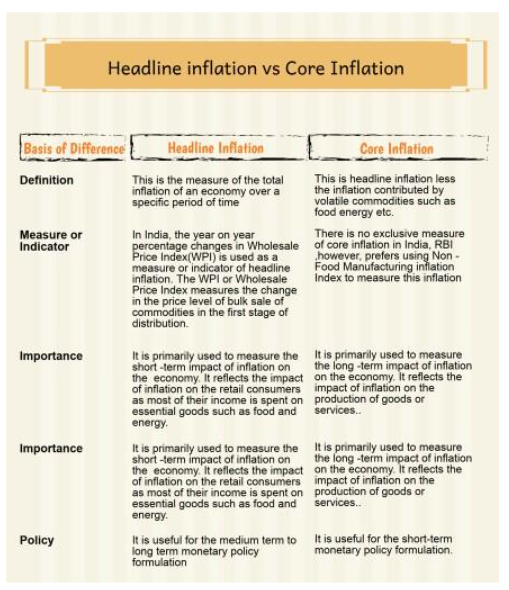Blog
Editorials
Daily Editorials
Editorials In-Depth, 29 March
Core inflation and its Impact
General Studies- III (Indian Economy)
BY Chrome Ias
Share
Trending
Latest Courses
Recently, The Monetary Policy Committee (MPC) of the Reserve Bank of India (RBI) has announced its decision to hold the benchmark repo rate unchanged at 4%.
- MPC has resolved to stick with its ‘accommodative’ policy stance in the next fiscal year to help support economic recovery amid the COVID-19 pandemic.
- The MPC opined that inflation was likely to remain elevated, “barring transient relief in the winter months from prices of perishables”.
- This, it stressed, “constrains monetary policy at the current juncture from using the space available to act in support of growth”.
The projection on CPI inflation
The rate-setting panel noted that the recovery appeared to be “far from being broad-based” and was dependent on sustained policy support.
- The policy support is offered by the central bank through a raft of measures to ensure that credit availability remains adequate.
- Consumer Price Index (CPI) inflation, the RBI said, would average 6.8% for Q3 and 5.8% in Q4 before easing to a 5.2% to 4.6% range in the first half of the next financial year, starting April 2021.
What is core inflation and why is it important?
Core inflation helps measure inflation after excluding the effects of temporary volatility, especially from prices of items such as fuel and food.
For example, seasonal spikes in food prices may skew the inflation rate, but the effect is only transitory.
- The RBI’s action on rates, however, affects the economy with a lag, by which time the spikes in the price of those food items may have reversed. Viewing inflation after stripping out such volatility helps give it a better picture of the underlying trend in prices.
- In its recent statement, the MPC noted: “Cost-push pressures continue to impinge on core inflation, which has remained sticky and could firm up as economic activity normalises and demand picks up.”

How does India measure retail inflation?
Inflation is the rate of change in the prices of a given set of items.
- India bases its retail inflation metrics on the Consumer Price Index (CPI).
- The index records changes in prices for a sample of family budget items that are representative of what consumers typically spend their household income on — food, fuel, housing, clothing, health, education, amusement and even paan, tobacco and intoxicants.
- The measure is based on a weighted average.
- That is, some items in the index may get greater weightage depending on their priority in a typical family’s budget.
- The CPI-based retail inflation is measured monthly and is published as a percentage value of change in the index from the corresponding year-earlier period.
- Data for a certain month are released by the Ministry of Statistics and Programme Implementation generally on the twelfth day of the subsequent month.
Why is faster inflation a concern for policymakers?
- Faster retail inflation is indicative of prices of household items rising quickly.
- While inflation affects everyone, it is often referred to as a ‘tax on the poor’ as the low-income stratum of society bears the brunt.
- Persistent high inflation pushes several items out of reach for this category of consumers.
For example:
Onions and potatoes are generally a key staple in an average Indian family’s diet. But, if the price of potatoes starts rising rapidly, a poor household is often forced to sharply reduce or forgo its consumption of this key source of essential nutrients, including carbohydrates.
- Over time, if unchecked, persistent high inflation erodes the value of money and hurts several other segments of the population, including the elderly living off a fixed pension.
- It hence ends up undermining a society’s consumptive capacity, and thereby, economic growth itself.
What is the RBI’s role in tackling inflation?
The RBI’s explicit mandate is to conduct monetary policy.
According to RBI’s website:
“The primary objective of monetary policy is to maintain price stability while keeping in mind the objective of growth. Price stability is a necessary precondition to sustainable growth.”
- In 2016, the Reserve Bank of India Act, 1934, was amended to provide a statutory basis for the implementation of a flexible inflation-targeting framework.
- Thus the Centre and the RBI would review and agree upon a specific inflation target every five years.
- Under this, 4% was set as the Consumer Price Index (CPI) inflation target for the period from August 5, 2016, to March 31, 2021, with the upper tolerance limit of 6% and the lower tolerance limit of 2%.
- The RBI through its MPC constantly assess current levels of inflation and prices of various goods and services in the economy.
- RBI also take into consideration inflation expectations both of consumers and financial markets so as to use an array of monetary tools, including interest rates, to contain inflation within its target range.
Source: The Hindu
BY Chrome Ias
Trending
Latest Courses
For Daily Updates
Sign up for daily emails to get the latest Chrome IAS news.





